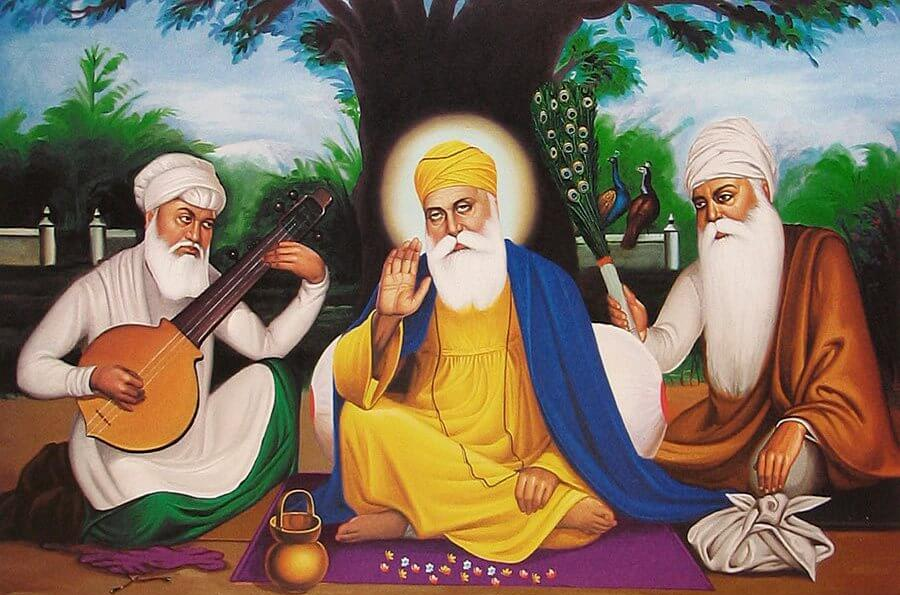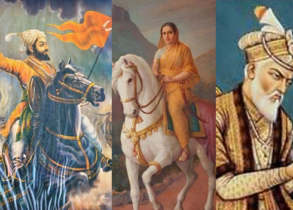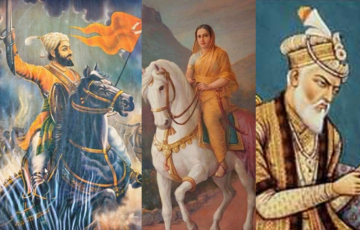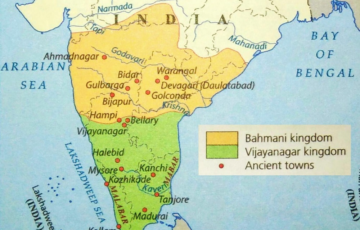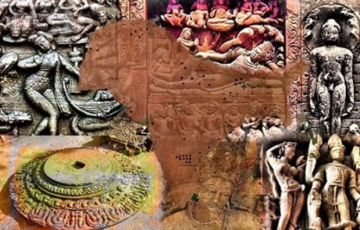BHAKTI AND SUFI TRADITIONS
The term ‘Bhakti’, meaning ‘devotion’, denotes a movement emphasizing intense emotional attachment and love between a devotee and a personal deity, originating in South India between the 7th and 10th centuries CE. This movement found expression in the poems of Alvars and Nayanars, addressed to Lord Vishnu and Lord Shiva, respectively.
Bhakti spread to North India, notably appearing in the 10th-century Sanskrit text, the Bhagavata-Purana. It gained momentum in east and north India from the 15th century onwards, reaching its zenith between the 15th and 17th centuries CE. Bhakti saints opposed the austerities promoted by Buddhist and Jain schools, advocating that ultimate devotion to God leads to salvation.
The Bhagavad Gita, a Hindu religious text, acknowledges Bhakti-marga as superior to the paths of knowledge (Jnana) and ritual and good works (karma) for attaining salvation.
Sources for Studying the Bhakti Movement
- Literature and Poetry:Regional languages contain a wealth of literature, devotional songs, and poetry that serve as primary sources for studying the Bhakti Movement. For example, Jayadeva’s “Gita Govinda” portrays the love between Krishna and Radha, while the Tamil hymns of Alvars provide further insights.
- Hagiographies:Biographical accounts of Bhakti saints, often written by their followers or sect members, offer valuable insights into their lives and teachings. For instance, the “Janam-Sakhi” focuses on the life of Guru Nanak.
- Oral Traditions:Oral transmission, narratives, and storytelling play a significant role in preserving and transmitting Bhakti traditions. For example, the Telugu art form of Burra Katha in Andhra Pradesh serves as a means of oral storytelling, passing down Bhakti-related narratives through generations.
Causes for the Emergence of the Bhakti Movement
- Superstitious Beliefs: The complexity of Hinduism, compounded by superstitious beliefs, created a fertile ground for the Bhakti Movement to emerge.
- Caste System and Social Inequality:The rigid caste system, untouchability, and social inequality prevalent in society led to dissatisfaction among different segments of the population.
- Influence of Islam: The teachings of Islam, which emphasized the unity of God and the brotherhood of man, appealed to the oppressed masses and provided an alternative to the existing religious structures.
- Preaching of Religious Leaders:Religious leaders across India advocated pure devotion, known as Bhakti, to combat issues like fanaticism, bigotry, and religious intolerance, thus contributing to the birth of the Bhakti Movement.
Reasons behind the movement:
- Response to corrupted practices in Hinduism.
- Emergence of influential reformers.
- Influence of Sufi sects and Vaishnavism/Shaivism ideologies.
Key teachings associated with the Bhakti movement include:
- Preaching equality, transcending divisions of religion, caste, and gender. For example, disciples of Ramananda hailed from diverse backgrounds.
- Advocating universal brotherhoodbased on values like love and care, exemplified by Kabir’s teachings through his Dohas.
- Striving to eradicate societal evils, as demonstrated by Guru Nanak’s condemnation of caste differences and ritualistic practices.
Central to the movement is the emphasis on Bhakti as the path to realizing God and achieving salvation, surpassing superficial rituals.
Alvars and Naynars
| Aspect | Alvars | Nayanars |
| Period | 5th – 10th centuries | 5th – 10th centuries |
| Deity of Devotion | Lord Vishnu | Lord Shiva |
| Contribution | Their hymns, known as Divya Prabandha, emphasized devotion through love and ecstasy. | Collected hymns into an anthology called the Tevaram, highlighting devotion to Lord Shiva. |
| Key Figures | Not specifically mentioned, but their collective works are significant. | Notable poets include Nanachampantar, Appar, and Chuntaramurtti, known as “the three”. |
| Impact on Bhakti Movement | Played a crucial role in shifting from ritual-oriented Vedic religion to a devotion-based path for salvation. | Contributed to the Bhakti movement with a strong emphasis on devotion to Shiva. |
Bhakti Movement Schools of Thought:
| School of Thought | Beliefs | Notable Figures |
| Nirgunabhakti | Focus on formless worship, introduced by Adi Shankara. | Adi Shankara, Kabir, Guru Nanak, Dadu Dayal |
| Sagunabhakti | Emphasizes worship of form, believing God is the manifestation of everything perfect. | Ramanuja, Nimbaraka, Madhva, Vallabha, Meera Bhai, Chaitanya Mahaprabhu, Tulsidas, Surdas
|
VEDANTA SAINTS AND THEIR CONTRIBUTIONS:
| Shankaracharya (788 – 820 AD)
● Birth: Kelara, Death: Uttarakhand (Kedarnath) ● Guru: Govinda Bhagavath pada ● Integrated Buddhist essence into Hindu thought, interpreting Vedic religion. ● Consolidated Advaita Vedanta (Non-Dualism) doctrine, emphasizing unity of God and the created world, and the identity of the individual soul with Brahman. ● Organized the Dashanami monastic order and unified Shanmata tradition of worship. Notable biography: Brhat-Sankara-Vijaya by Citsukha. |
| Ramanujarcharya (1017-1137 AD)
● Birth: Tamil Nadu ● Guru: Yadav preksha ● Propagated Vishishtadvaita Vedanta or qualified monism, affirming plurality and distinction between Ātman (soul) and Brahman (ultimate reality). ● Key figure in Sri Vaishnavism tradition. Notable literary works: Vedartha Sangraham, Sri Bhashyam, Gita Bhashyam. |
| Nimbarka
● Contemporary of Ramanuja. Propounded the philosophy of ‘bheda-bheda’, emphasizing identical yet distinct nature of God, soul, and the world. |
| Madhvarchaya (1238-1319 AD)
● Critic of Shankara’s Advaita Vedanta and Ramanuja’s Vishishtadvaita Vedanta. ● Preached “Dvaita” or dualism, positing divinity as separate from human conscience/soul. ● Emphasized liberation through the grace of God. Notable work: Anuvyakhyana. |
| Nathpanthis, Siddhas, and Yogis:
● Criticized ritualism and societal norms through logical arguments. ● Advocated renunciation and meditation on formless god for salvation. ● Promoted intense mental and physical training via yoga practices, meditation, and breathing exercises. Particularly popular among lower castes, offering a path to salvation outside conventional societal structures. |
SAINTS AND THEIR CONTRIBUTION TO THE BHAKTI MOVEMENT
| Saint | Contribution |
| Jnaneshwar (1275-1296 AD) | ● A revered saint of Maharashtra, Jnaneshwar worshipped Vishnu as Vithoba or Krishna.
● He translated the Bhagavad Gita into Marathi, known as Jnaneshwari. |
| Tulsi Das (1532-1623 AD) | ● A popularizer of the Rama cult, Tulsi Das rendered Rama’s story into Hindi, composing notable works like Ramcharitmanas and Gitavali during the reigns of Akbar and Jahangir. |
| Shankaradeva (1499-1569 AD) | ● Championing Vaishnavism in Assam, Shankaradeva endorsed ‘naam kirtan’ and advocated for spiritual growth through monasteries and prayer halls.
● His notable poetical composition is “Kirtana-ghosha” in Brajavali language. |
| Baba Guru Nanak (1469-1538 AD)
|
● Born near the Ravi river, Guru Nanak advocated Nirguna bhakti, believing in a formless, genderless Absolute called “rab.”
● He established Sikhism, emphasizing collective worship centered on “sangat” and “shabad” hymns, rejecting rituals and scriptures of both Hindus and Muslims. |
| Vallabhacharya (1479-1531 AD)
|
● Founder of Pushtimarg, Vallabhacharya emphasized devotion to child Krishna through Vatsalya Bhakti and advocated householdership for Vaishnava devotees.
● He propagated Shuddadvaita philosophy and established Pushtimarg seats across India during his pilgrimages. |
| Kabir (1398-1448 AD)
|
● Likely a weaver from Varanasi, Kabir learned Vedanta philosophy from Swami Ramananda and was influenced by the Muslim Sufi, Shaikh Taqi.
● His poems blend Sufi and Hindu ideas, denouncing idol worship, polytheism, and the caste system. ● Kabir’s verses exist in traditions preserved by the Kabirpanth, Dadupanth, and Adi Granth Sahib. |
| Ramananda (1400-1470 AD)
|
● A follower of Ramanuja, Ramananda preached Vaishnavism in Hindi, being the first to do so in the vernacular language.
● Devoted to Rama and educated in Benaras, he introduced radical changes in Vaishnavism, advocating love and devotion to Rama and Sita. ● He advocated equality before God, rejecting caste supremacy, and welcomed followers from all backgrounds, famously emphasizing not to inquire about one’s sect or caste. |
| Chaitanya (1485-1533 AD) | ● Known as “Mahaprabhu,” Chaitanya was a Bengali saint devoted to Krishna, popularizing “Sankirtan” in Bengal.
● His movement exalted the superiority of Krishna and championed love and tolerance, opposing caste inequalities. |
| Tukaram (1608-1649 AD)
|
● Tukaram composed Abhangas in Marathi, devotional songs praising Lord Vithoba of Pandarpur.
● Living in the times of Chhatrapati Shivaji, Jahangir, and Shahjahan, alongside saints like Eknatha and Ramdas, he rejected Vedic sacrifices, pilgrimages, and idol worship, believing in a formless god. ● Tukaram advocated for equality, brotherhood, and Hindu-Muslim unity, themes reflected in some of his verses. |
| Guru Ramdas (1608-1681 AD) | ● Renowned as a teacher and spiritual guide to Chhatrapati Shivaji, Guru Ramdas stressed the equality of all men before God.
● Beyond religious preaching, he was a visionary nation-builder. |
| Sur Das
|
● Sur Das, known as the blind bard of Agra, lived at the court of Akbar and was possibly a disciple of Vallabacharya.
● Preaching love and devotion to a personal God, he wrote inspiring Hindi poems about Lord Krishna, with Krishna’s Baal Lila being a central theme. |
| Mirabai (1498-1546 AD)
|
● Born into royalty in Merta (Rajasthan), Mirabai renounced traditional marital roles to live as a wandering saint, composing intense songs devoted to Krishna.
● A prominent female poet in the bhakti tradition, she advocated Saguna bhakti, and her songs remain popular among underprivileged communities. |
| Janabai (1258-1350 AD) | ● Born into a ‘low’ caste family in Maharashtra, Janabai served as a disciple of Namadeva, penning over 300 poems reflecting the challenges of her social status and domestic life. |
| Bahinabai or Bahina (1628-1700 AD)
|
● A poet-saint from Maharashtra, Bahinabai wrote abhangas depicting women’s daily labors, blending her profound love for Lord Vithoba with her marital duties and responsibilities toward her husband.
● Despite her Brahmin background, she revered the low-caste poet-saint Tukaram, prioritizing devotion over traditional purity norms. |
The Sufi Movement:
- In the 12th century AD, amidst the rising materialism within the Caliphate, certain individuals in Persia turned towards asceticism, forming what would become known as the Sufis.
- The Sufi movement found its roots in India around 1300 AD, gradually expanding to South India by the 15th century.
- Sufism, also referred to as tasawwuf, represents the mystical dimension of Islam, delving into the inner aspects of the Islamic creed.
- The term “Sufi” derives from “suf,” meaning wool, as these individuals often wore long woolen garments as a symbol of their asceticism.
- Functioning as a liberal reform movement within Islam, Sufism emphasized love and devotion as potent paths towards the realization of God.
- Central to Sufism is the relationship between Pir (Teacher) and Murid (Student),fostering spiritual guidance and growth.
- Sufism traces its philosophical roots to the doctrine of Wahdat-ul-wajood, or the unity of being, as expounded by Ibn-ul-Arabi (1165-1240 AD).
- Among the early Sufi saints were figures like Rabia and Mansur bin Hallaj, known for their profound spiritual insights and devotion.
- Sufi orders are broadly categorized into two groups: Ba-sara, adherents who followed Islamic law, and Be-shara, those who transcended conventional Islamic practices.
- In Sufism, self-discipline was regarded as a crucial prerequisite for attaining knowledge of God, emphasizing inner purity over external conduct.
- The entry of Sufism into India occurred between the 11th and 12th centuries, with Al-Hujwari, popularly known asData Ganj Baksh (the Distributor of Unlimited Treasure), being one of the earliest Sufis to settle in the region, passing away in 1089 AD.
- The early centers of Sufism in India were Multan and Punjab, with its influence eventually spreading to regions like Kashmir, Bihar, Bengal, and the Deccan.
| THE ESSENTIAL CHARACTERISTICS OF SUFISM
● Fana: Spiritual merger of devotee with Allah ● Insan-e-kamil: Perfect human with all good virtues, ● Zikr-tauba: remembrance of god all the time(zikr), ● Wahdatul-wajood: one god for the entire universe; unity of god and being. ● Sama: spiritual dance and music to promote their concepts, though music is un-Islamic. |
THREE STAGES IN THE HISTORY OF SUFISM
| Stage | Description | Characteristics |
| Khanqah Stage | This initial phase is characterized by the establishment of Sufi lodges or retreats known as Khanqahs. | ● Focus on communal living and spiritual gatherings.
● Sufi masters (Sheikhs) provide guidance to disciples (Murids). ● Emphasis on meditation, prayer, and ascetic practices. |
| Tariqa Stage | In this developmental stage, formalization of Sufi orders or brotherhoods, known as Tariqas, occurs. | ● Establishment of structured spiritual paths or methodologies.
● Formalization of the master-disciple relationship. ● Spread of specific rituals, teachings, and spiritual practices. |
| Tarifa Stage | This later stage involves the expansion and diversification of Sufi teachings and practices. | ● Greater emphasis on the personal experience of the divine.
● Development of distinct Sufi paths and philosophies o Integration of Sufi practices with local cultures and traditions. |
Sufism and Music: Embracing Poetry, Music, and Cultural Flourishment
- Sufism, the mystical facet of Islam, advocates for the use of music as a means to deepen one’s connection with the Divine, whether through zikr(recitation of the Divine name) or sama, the performance of mystical music.
- Sufi scholars and poets have contributed significantly to literature, producing a rich array of poems, prose, anecdotes, and fables. Among these, Amir Khusrau, a disciple of Nizamuddin Auliya, stands out as one of the most notable figures.
- Moreover, Sufi saints are credited with the invention of musical instruments such as the sitar and tabla, paving the way for the evolution of classical music. The Khayal style of music owes much to the influence of Sufism.
- Amir Khusrau, often referred to as the “Parrot of India,” played a pivotal role in shaping Sufi music, giving it a unique form known as sama. He is hailed as the “Father of Qawwali,”and his compositions are still sung in dargahs (Sufi shrines) across the country.
Important Features: Rejection, Orders, and Spiritual Principles
- Sufis rejected the intricate rituals and codes of conduct prescribed by traditional Muslim scholars, emphasizing instead a direct and intimate relationship with God, whom they viewed as thebeloved (Mashuq), while they themselves were seen as lovers (Ashiqs).
- Sufism was organized into twelve orders (Silsilas), each led by a mystic Sufi saint. Among the most prominent orders were the Chistis, Suhrawardis, Qadiriyahs, and Naqshbandis, with each order tracing its lineage back to its founding figure.
- The concept of Silsila signifies the continuous connection between the Murshid (teacher) and the Murid (student), often within the confines of a Khanqah, a hospice of worship.
- Sufism transcended both rural and urban settings, exerting a profound social, political, and cultural influence on society.
- Devotion held greater significance inSufism than fasting (Roza) or prayer (Namaz), and it actively rejected the caste system.
- Drawing extensively from Hindu Vedanta philosophy, Sufism embraces cardinal doctrines such as complete surrender to the Divine will, self-annihilation, and the pursuit of spiritual perfection.
- The concept of Fana, or annihilation of human attributes through union with God, epitomizes the core principles of Sufism, wherein a perfected being is referred to as a Wali, or a sincere friend of God.
Orders of Sufism (Silsilah)
(1) Chishtiya order.
(2) Qadriya order
(3) Suharwardiya order
(4) Naqsh bandiya order.
Chishti Order
- Founded by:Khwaja Moin-Uddin Chishti, after migrating to India from Central Asia, encouraged by his guide, Khwaja Usman.
- Arrival:Accompanied Muhammad Ghori’s army in 1192, eventually settling in Ajmer.
- Belief:Advocated devotional music as a path to God.
- Influence: Became a leading Sufi group by adapting to local customs and incorporating Indian devotional traditions.
- Practices: Included bowing before the Shaikh, offering water to visitors, initiating rituals like shaving heads, and incorporating yogic exercises.
- Function: Served as a social hub with facilities for living, praying, and shelter during threats like Mongol invasions.
- Visitors:Attracted poets and historians, including Amir Hasan Sijzi and Amir Khusrau.
- Pilgrimage (Ziyarat):Common practice involving music, dance, and chants at saints’ tombs, most notably Khwaja Muinuddin’s shrine.
- Spiritual Practices:Emphasized ‘zikr’ (Divine Names) and ‘sama’ (mystical music) for divine connection.
- Language Use: Utilized Hindavi for wider communication.
- Literary Contributions:Produced significant poetry symbolizing divine love, including Malik Muhammad Jayasi’s “Padmavat”.
- Support: Accepted grants and land from rulers, enhancing their influence without political isolation.
- Royal Patrons:Received support from figures like Sultan Ghiyasuddin Khalji and Mughal emperors, including frequent visits from Emperor Akbar to Khwaja Muinuddin’s shrine.
- Interactions with Rulers:Though they occasionally faced conflicts with Sultans, Chishti Sufis were revered for their piety and perceived miraculous abilities.
Qadriya Order:
- Similarity:Shared practices with Chishtis but emphasized allegiance to elders.
- Introduction: Arrived in India in the late 14th century, gaining popularity with Ibnul Arabi’s inclusion.
- Philosophy: Advocated Wahdat-ul-Wujood (Unity of Existence).
- Significance: Less prominent in India compared to other major orders.
- Associations: Urdu poets Hasrat Mohani and Muhammad Iqbal were followers.
Naqshbandi Order:
- Founder:Khwaja Baha-ul-din Naqshband, popularized by Khawja Naseer-ul-din Ubaidullah Ahrar.
- Introduction:Entered India with Babur’s invasion.
- Tolerance:Less tolerant compared to Chishtis, Qadries, and Suharwardis.
- Origins:Traced back to the first caliph, Abu Bakr.
- Approach: Known for a puritanical and austere stance, recommended imposing jaziya on Hindu subjects.
- Notable Figures:Included Shaikh Ahmad Sir Hindi, who criticized Akbar’s religious policies.
- Philosophy: Initially aligned with Wahdat-ul-Wujood, later evolved to Wahadul-ul-Shahood under Shaikh Ahmad Sir Hindi.
- Contributors: Produced significant saints like Khwaja Khurd, Ahmad Sir Hindi, and Shah Wali-ullah.
Suharwardi Order:
- Founder:Sheikh Shahabuddin Suharwardi Maqtul, introduced the doctrine of light (Nur) in Sufism.
- Prominence: Bahauddin Zakarya popularized it in Northern India.
- Wealth:Valued wealth accumulation for serving humanity.
- Duration:Remained briefly popular, introduced after the Chishti order.
| Important facts
● The Bhakti movement was started by Alwar Saints. ● Samkaras philosophy is called Non-dualism. ● The common belief of life of both Buddha and Mirabai was that the world is full of sorrow. ● ‘Let no man ask a man’s sect or caste’ was the dictum of Ramananda. ● Vaishnavism in Kamarupa was popularised by Shankaradeva. ● Shankaradeva introduced Vaishnavism in Assam and Cooch Behar. ● Ramanujacharya is related to Vishistadvaita. ● “Shuddha Advaitvad” was propounded by Vallabhacharya. ● The birthplace of “Mahaprabhu Vallabhacharya” was Champaranya. ● Ramananda was the first Bhakti Saint to use Hindi for the propagation of his message. ● Kabir was a disciple of Ramananda. ● ‘Bijak’ was composed by Kabir. ● A collection of dialogues between Kabir and Dharamdas is titled ‘Amarmul’. ● Malukdas was a saint poet of Kada. ● The name of Saint Ghasidas’s father was Mahangu. ● Gurumukhi was started by Guru Angad. ● There are 12 Jyotirlingah devoted to Lord Shiva. ● The birthplace of Guru Nanak was Nankana. ● Guru Nanak founded the Sikh religion during the period of Sikandar Lodi. ● The theory “God knows man’s virtues and enquires not his caste, in the next world there is no caste!” was of Nanak. ● Mirabai was contemporary of Tulsidas. ● The husband of famous devotee poet Mira was Rajkumar Bhojraj. ● ‘Rag-Govind’ was written by Mirabai. ● Namdev was influenced by Islam among the Saints of Bhakti Movement. ● Dadu Dayal and Guru Nanak were preaching when the Lodi dynasty fell and Babur took over. ● Tulsidas was contemporary of Akbar and Jahangir. ● Sahitya Ratna is not a composition of Saint Tulsidas. ● The main seat of Varkari sect is situated at Pandharpur. ● Bhakt Tukaram was a contemporary of Jahangir. ● The “Chishtia Sufi Order” in India was established by Khwaja Muinuddin. ● Khwaja Abu-Abdal founded the Chishtia Branch of Sufism. ● Khwaja Usman Haruni was the mentor of Khwaja Muinuddin Chishti. ● Khwaja Muinuddin Chishti was a disciple of Khwaja Usman Haruni. ● Raja Sahu, the grandson of Shivaji, was the first to offer a gift at the Dargah of Khwaja Muinuddin Chishti of Ajmer. ● Shaikh Nizamuddin Auliya was the disciple of Baba Farid. ● Amir Hassan Sizzi compiled the book ‘Fawaidul Fawad’ recording the conversations of Shaikh Nizamuddin Auliya. ● The Dargah of Shaikh Nizamuddin Auliya is situated in Delhi. ● Amir Hasan is called the ‘Sadi of India’ for his great Ghazals. ● Alauddin Khalji was refused an audience by Nizamuddin Auliya. ● Shaikh Nizamuddin Auliya is known as Mahboob-i-Ilahi. ● Fariduddin-Ganj-i-Shakar’s thoughts were incorporated into the religious book ‘Adi Granth’ of the Sikhs. ● Shaikh Salim Chishti was given the title of Shaikh-ul-Hind. ● The Naqshbandi order of Sufis was the most orthodox. ● Rahim and Raskhan were associated with Sufism. ● Naqshbandiya was against music. ● Nasiruddin is known as ‘Chirag-e-Delhi’. ● Shah Muhammad Ghaus regarded Krishna among the auliyas. ● Many Sanskrit works on music were translated into Persian during the medieval period, and the early Chishti Sufis were fond of musical assemblies called ‘sama’. ● Raskhan composed ‘Prem Vatika’. ● ‘Barahmasa’ was composed by Malik Muhammad Jayasi. ● A fair is held at the tomb of Haji Waris Ali Shah at Dewa Sharif. |
UPSC PREVIOUS YEAR QUESTIONS
1. Consider the following statements: [2019]
1. Saint Nimbarka was a contemporary of Akbar
2. Saint Kabir was greatly influenced by Shaikh Ahmad Sirhindi
Which of the statements given above is/are correct?
a) 1 only
b) 2 only
c) Both 1 and 2
d) Neither 1 nor 2
Answer d
2. With reference to the cultural history of medieval India, consider the following statements: [2016]
1. Siddhas (Sittars) of Tamil region were monotheistic and condemned idolatry.
2. Lingayats of Kannada region questioned the theory of rebirth and rejected the caste hierarchy.
Which of the statements given above is/are correct?
a) 1 only
b) 2 only
c) Both 1 and 2
d) Neither 1 nor 2
Answer c
3. Consider the following Bhakti saints: [2013]
1. Dadu Dayal
2. Guru Nanak
3. Tyagaraja
Who among the above was/were preaching when the Lodi dynasty fell and Babur took over?
a) 1 and 3
b) 2 only
c) 2 and 3
d) 1 and 2
Answer b
4. Evaluate the nature of Bhakti Literature and its contribution to Indian culture. (2021)
5. The Bhakti movement received a remarkable re-orientation with the advent of Sri Chaitanya Mahaprabhu. Discuss. (2018)
6. Sufis and medieval mystic saints failed to modify either the religious ideas and practicesor the outward structure of Hindu / Muslim societies to any appreciable extent.Comment. (2014)

